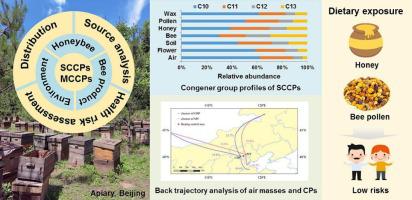当前位置:
X-MOL 学术
›
Sci. Total Environ.
›
论文详情
Our official English website, www.x-mol.net, welcomes your feedback! (Note: you will need to create a separate account there.)
Bee colonies map the short- and medium-chain chlorinated paraffin contamination from the apiary environment
Science of the Total Environment ( IF 9.8 ) Pub Date : 2024-03-20 , DOI: 10.1016/j.scitotenv.2024.171846 Shujun Dong , Suzhen Qi , Yazhou Zhao , Su Zhang , Xingyi Wu , Jun Cao , Yun Zou , Yuesen Wang , Simeng Xia , Peilong Wang , Liming Wu
Science of the Total Environment ( IF 9.8 ) Pub Date : 2024-03-20 , DOI: 10.1016/j.scitotenv.2024.171846 Shujun Dong , Suzhen Qi , Yazhou Zhao , Su Zhang , Xingyi Wu , Jun Cao , Yun Zou , Yuesen Wang , Simeng Xia , Peilong Wang , Liming Wu

|
Chlorinated paraffins (CPs) are industrial chemicals that have potential adverse effects in the environment and on human health. This study investigated CPs in apiary environment, honeybees, and bee products from two rural areas of Beijing, China. The median concentrations of short-chain CPs (SCCPs) and medium-chain CPs (MCCPs) were 22 and 1.6 ng/m in the ambient air, 1350 and 708 ng/g dry mass (dw) in bees, 1050 and 427 ng/g dw in flowers, 37 and 54 ng/g in honey, 78 and 53 ng/g dw in bee pollen, 36 and 30 ng/g dw in soil, and 293 and 319 ng/g dw in bee wax. CCl and CCl dominated SCCPs and MCCPs in these samples, respectively. The concentrations and distributions of CPs in samples from apiaries located in the two regions varied. Long-range transportation of air masses was identified as an important source of CPs in apiaries. A close relationship between CPs in bees and the apiary environment indicated that bees could act as bioindicators for CP contamination in the environment. A human health risk assessment found that there were low risks for adults and children exposed to CPs through consumption of honey and pollen from the studied regions.
更新日期:2024-03-20



























 京公网安备 11010802027423号
京公网安备 11010802027423号